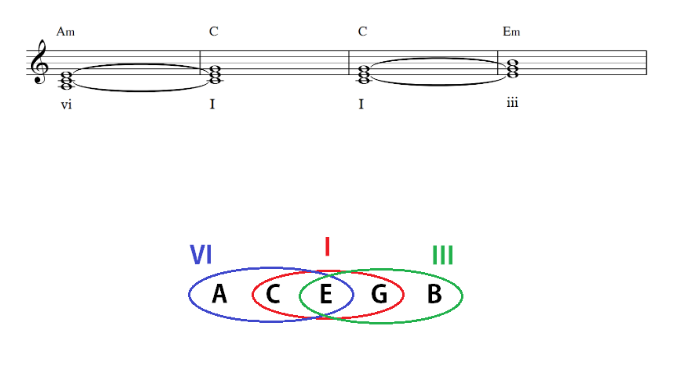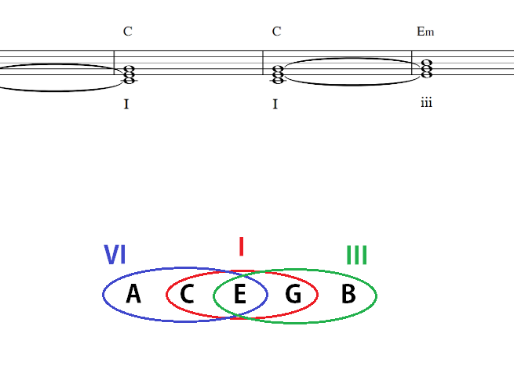Music Theory Resoucers
Tonal Families: Introduction to Chord Substitution – Function 1
Chords in the key of c:

Example C Major scale in piano chords
Within a scale, we have seven diatonic chords. With the term diatonic I mean chords that belong to a specific scale. By looking at the triads we build on top of every note (or degree when referring to a harmonic function) it is possible to group the chords into chord families – or harmonic functions, if you prefer – that share similar harmonic properties. As each note has a specific function within a scale, the chord above it does as well. This will be particularly useful when we implement chord substitutions, which is very useful in writing or arranging songs and in Jazz improvisation as well.
But what is a harmonic function in the first place?
We can define it as the role that a particular chord plays in the creating of a larger harmonic progression, either belonging to the scale (diatonic chords) or not belonging to it (chromatic chords). In this article we will focus on the diatonic triads.
Let’s see an example in C major scale in the image above, and let’s take it to explain the chord substitution.
Within the diatonic chords, we can classify the harmonic functions into 3 main ones:
1 – Tonic family
2 – Subdominant family (also called Pre-Dominant)
3 – Dominant family
1 – Tonic Family
These three families have a specific purpose and effect within a harmonic progression. Let’s delve into this topic: In general terms, in music, we can talk about three different moments: stability, local activity and directional motion.
The tonal family chords portray the stability within a harmonic progression. This means that we can stay longer on these chords without the risk of a monotonous effect. They set the key in which the music is and the rest of the chords will have a natural tendency to go back to tonal family chords; they tend to express the tonal foundation of the piece as well and therefore, they are often seen at the beginning and end of a piece or section.
Within a scale, they are represented by the Tonic or First degree (I), the Mediant or third-degree (III) and the Sub-Mediant or sixth degree (VI)
The intervallic relations between these three chords is simple: from the tonic, we move 3 notes down to the VI and if we move three notes up from the same note we will arrive at the III. Here we have an example in the key of C major:

Now see how this is translated to musical notation:

See above how the three chords are intertwined: they always share two notes between the tonic chord and the rest of the chords of the same family.
In the next articles, we will see the Subdominant (function 2) and Dominant family (function 3) and how they interact ( i iv v chords).
2- Subdominant families
This article will explore chord families, starting with the predominant (function 2) chords. Within this category of Pre-Dominant chords, we might find a wide variety such as IV, II (these two belonging to the Subdominant family chords), bII, different ‘augmented sixth’ chords, and secondary (applied) dominants of the dominant, such as VII7/V.
As already mentioned, these Subdominant chords can also be thought of as having Predominant function. Again, we can think of this in terms of a given piece of music. If, for example, our piece of music is in G major, then these harmonies, part of the key, have a function within that key, within that piece of music.
As already discussed, the tonal function provides some stability within a harmonic progression. The Predominant function, on the other hand, can be thought of as a continuation from the tonic function; we now have some musical movement, a further direction!
Since the Subdominant family of chords includes many different chords, it is easier to think of these chords as part of two main types: first: chords built above the 4th degree of the key in the bass, the ones that are dominant of the dominant (V/V).(the dominant of the dominant are mixed with subdominant chords, they are different families)
So what is the relationship between these chords? Let us have a look at IV and II. If we were in C major, the IV chord would contain F, A, C. The II harmony then, which starts on the second degree of the scale, would contain D, F, A. We see then that IV and II share two notes: the F and the A. So we can establish a relationship between these two harmonies and the dominant of the dominant. (dominant of the dominant is a major chords D – F#-A and D-f-A is a minor chord, they are different, and with different functions)
The dominant of the dominant meaning that if we take the dominant chord of a scale, in the case of C major being G, B, D, and then starting from that G, we count up 5 degrees, and then form a new chord, the note we would find from G up five notes would be D. Then the chord we would form would be: D, F sharp, and A.(F sharp as we think that the scale now being G major.). So this new chord is identical to II’s, except that the F has raised a semitone. And then that V/V shares again the notes F and A with the IV.
3- Dominant families:
The last harmonies we will talk about is the group of the Dominant harmonic function. It includes the V and VII chords in their various positions. In some instances, III can also function as a Dominant substitute, for example, in V – III – VI progression. In the case of the Classical period, in most cases, the V chord will be present in the Dominant Function, either in the form of its major triad or in the form of a major or minor seventh chord. If, for example, we were in the key of C major, then the major triad of the V would be G, B, D, and if it were the seventh chord, we would also see the note F.
Then, the VII chord, we would see it as a diminished triad in the first inversion (VII6) and a seventh chord with its three inversions (VII7). In the classical period, if these chords resolved to tonic harmony, which is often the case, we can think of them as having a Dominant function! So we see that, in many cases, the Function of the Dominant is to create the musical space to resolve the musical line and tension created back to Tonic harmony; This would happen in the form of a cadence!
So, let us now see the relationship between these chords. As we have seen, in the key of C major, the V chord would contain the notes: G, B, D, (F). The VII chord would contain B, D, F, (A). Then, the III chord, which is sometimes used, would contain E, G, B. We can then see that these chords share many notes. If we found the B chord as a seventh chord, it would share three notes with the VII chord, namely: B, D, F. The III chord shares the note B with all two chords and the note G with the V chord.
#adultpianolessons #compositionteachers #251chordprogression #fmajorchordpiano #chordsinthekeyofamajor #chordprogressionplayer #chordkeyboard #dmajorpianochord
#chordsandscales #chordsincmajor #chordsinthekeyofc #chordskeyboard #chordsonthepiano

